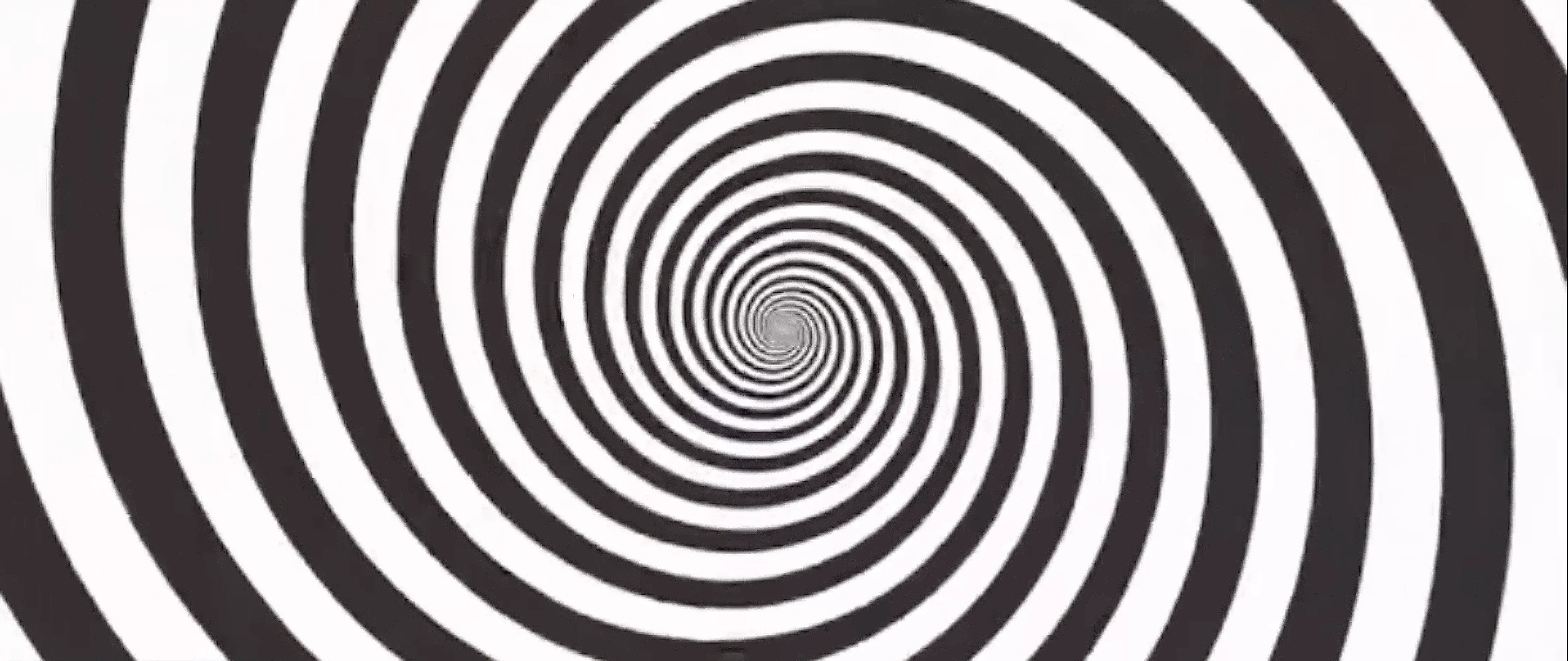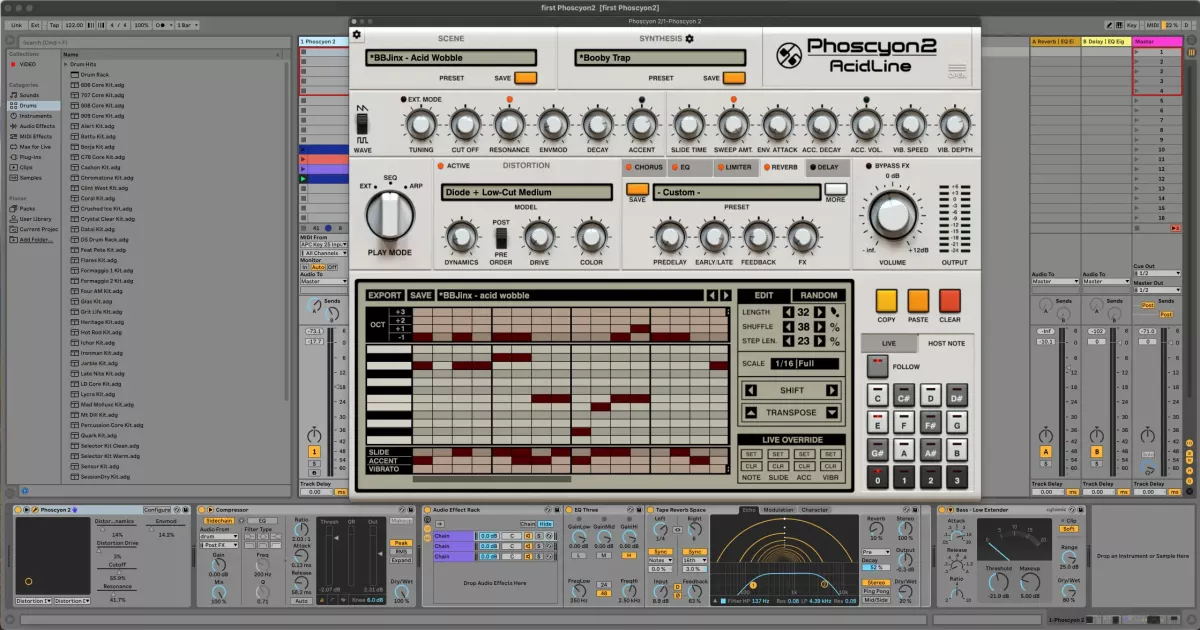
How to make the perfect acid bass sound with Phoscyon 2, the best TB303 emulation around
Learn how to create that squelching acid sound with one of the first TB303 VST emulations, and in our opinion still the best you can find: Phoscyon 2!
On YouTube
If you want to hear how things sound, you can watch this live demo of the discussed techniques on they synthicons YouTube channel
This is what you can find in the video:
- 00:00 partly switching from hardware to software in my live setup
- 01:19 quick tour in my Ableton demo project: Ableton drum rack, Lush 2, Phoscyon 2, Decimort 2 and Ableton effects racks
- 01:46 our Phoscyon 2 setup: automation of distortion, drive, envelope modulation, cut off and resonance
- 02:18 switching the Phoscyon 2 sequencer patterns using a single note in an Ableton clip
- 02:25 the vibrato tool, only available in Phoscyon 2
- 02:35 how to make full low bass notes
- 02:51 how to make that sharp squelching sound
- 03:06 some tips on how to apply cutoff and resonance
- 03:19 demonstration of parameter tweaking
- 04:06 splitting Phoscyon 2's output in 3 bands for further refinement, control and phatness
04:53 trancey outro :)
Live Performance
I’ve been around for a while now, and I’m a live performer, so I used to stayed away from CPU heavy plugins.
TB-303 Emulations on the Market
I tried many clones, both hardware and software. I own the MAM MB3 and the Cyclone Bassbot, but none of these offer the same versatility and sound quality as Phoscyon does.
In the software world, I tried some other brands, and some free plugins, too, but really, to be honest, don't go wasting your time on products that are just not killing it.
Software vs. Hardware
Since PCs got so powerful nowadays, computer outage doesn’t pose a problem anymore. On the contrary, I'm trying my hardest not to recall the sweaty moments onstage where my midi sync got lost for reasons I still can’t explain. Having my Jomox Alpha Base as a sync master proved a particularly painful experience on multiple occasions. And as much as I cherish tweaking “real” knobs on “real” instruments, you'll see me use software more and more in my live acts.
Knowing how perfect a Phoscyon sounds like, and how much more it offers than being a TB303 clone, the only reason why I can imagine wanting to go onstage with hardware pieces and the loads of cabling and headaches that come with them, is that I would want to turn this particular knob of this particular machine, which would be quite ridiculous if you ask me.
I certainly don’t want to downgrade the amazing sound coming from hardware beasts like the Alpha Bass or the more recent SH-1, or my Moog and the old Juno produce, but bringing that sound onstage is a totally different kettle of fish.

These are great times to drop all the cabling and syncing nightmares, and switch over to software!
As some of you already know, for soft synths, I turn to D16 Group. They pioneered in cloning hardware that makes you drool.

Also, I’ve been watching their company and products for a while, and I think buying from D16 is your best bet when it comes to customer support, product stability and updates, all of which are extremely important if you are serious about music production and live performance.
My Current Live Setup
D16 is getting a central spot in my live setup which used to look like this:
- I’m keeping the APC40 for clip triggering and automation handling
- The Pioneer RMX1000 is also staying, as is Ableton of course
- The Pioneer V10 LF stays as master out.
- I’m not sure about some of my midi and audio manipulation tools. I've used the Kaosspad and Midi Fighter without any issue in my performances, but I feel they somehow keep my focus away from more meaningful actions during the set. I do love playing around with both of them though!
- The S-1 will probably go. It's amazing how the mini AIRA series fit in such huge sounds, but the knobs are way too fiddly and there's no visual feedback to work your live set in a comfortable way…
- Now that I discovered Phoscyon, I will translate my Bassbot patterns into Phoscyon ; could be an interesting article on converting midi out from one to the other. Stay tuned :)
The Jomox Alpha Base will no longer leave my studio. Great sound, but not recommended for live performance! I've had the thing crash on the most crucial moments. You really need nerves of steel to have this item onstage. I'm just not in for such stress levels :-/ I'm considering D16s Drumazon 2, but need to see if and how I could make that work for live settings… More on that later 🤩
Making that ACID sound
So, let's go to our demo project here.
Project Setup
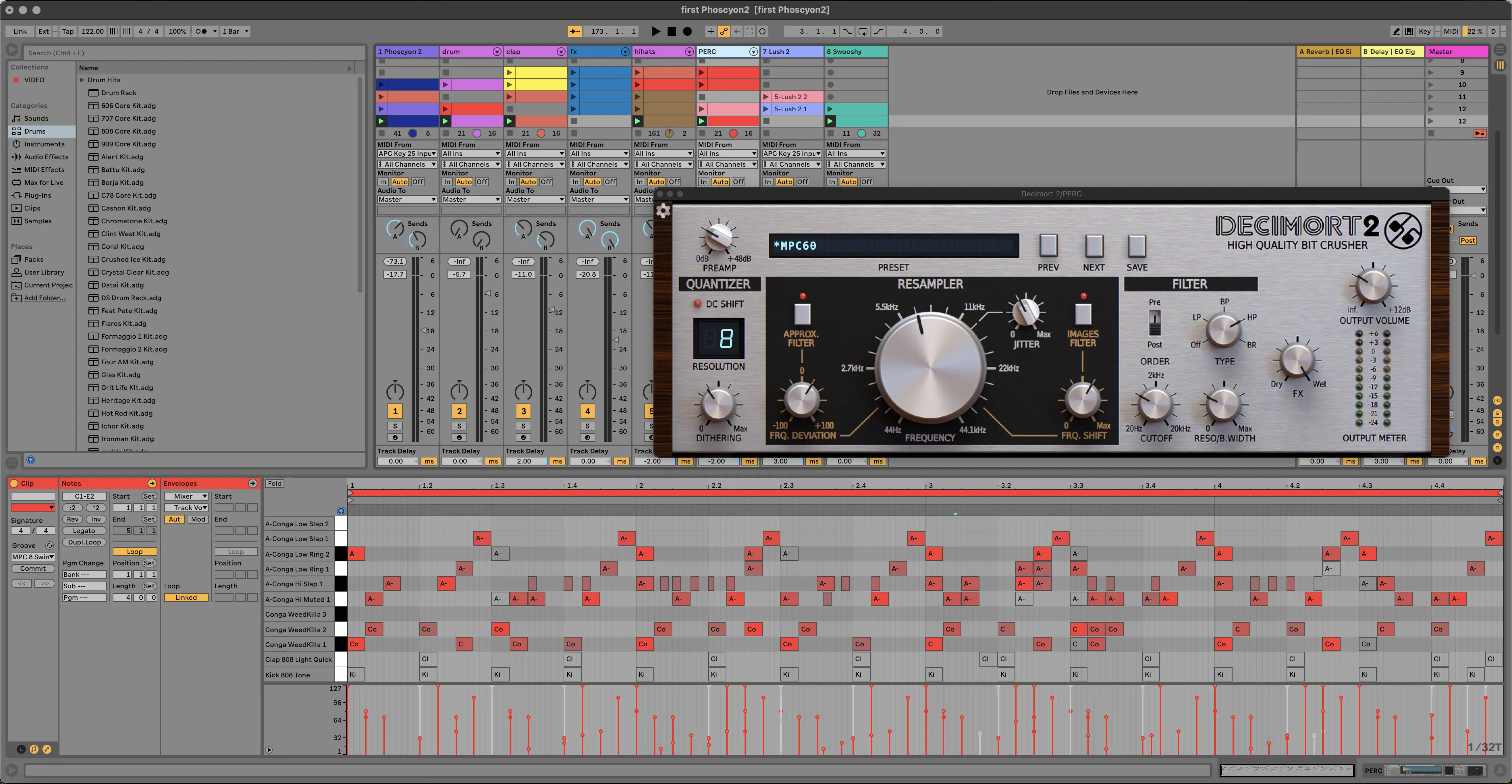
I’ve got these Congas from the Ableton factory pack, roughened up with D16’s Decimort, to make it sound like an old record, just using the MPC60 preset, and tweaking it a bit to my taste. I don't want to start sounding like a sales guy for D16, but yes, I can definitely recommend the Decimort bitcrusher!
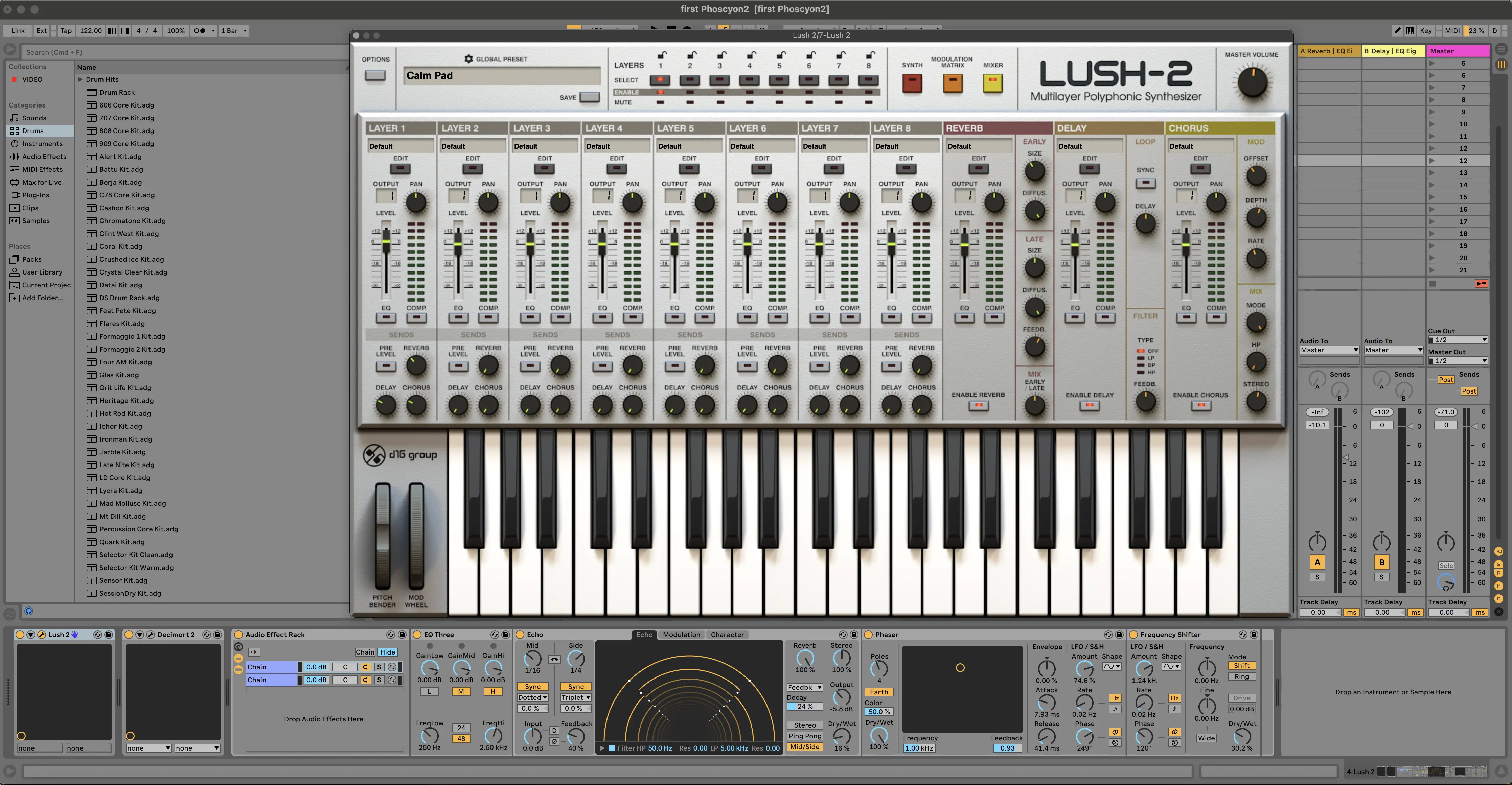
Here we have the incredible Lush 2 (indeed, D16 again - am I starting to bore you out?), which deserves an article of its own. My Lush instance is going through an FX rack, which splits the bands, and warps it using a frequency shifter and tape echo simulation, just to have some harmony going in the background.
And then there’s this absolute beast. The one this is all about. Enter Phoscyon 2.
![]()
Automation
![]()
I have automation set up for the built-in distortion, drive, envelope modulation and of course the resonance and cutoff. In Ableton this is easily done by clicking the “configure” button (cf. above image). Let’s turn some knobs, shall we? 🤯
You can already tell now that Phoscyon 2 definitely sounds like the real thing…
The ACID Bass Sequencer Pattern
I made a 32 step pattern with octave jumps and glides just before or on the jumps. That’s a common technique.
Here you find the 32 steps, with their respective accents, slides and octave jumps.
First 16 steps:
![]()
… and steps 17 - 32:
![]()
If you want that endless acid line, try making a 12 step sequence on a 16 beat pattern. It’ll go on and on without end! 🤡
How To Switch Between Patterns
![]()
The guys from D16 made switching between patterns dead easy. Say you are currently playing an Ableton clip which triggers the note C. Here's what you need to do to make Ableton play a different pattern with note C#:
- copy your first pattern under note C in Phoscyon using the “copy” button
- click on C# and click the “Paste” button in the Phoscyon interface
- Make sure you have Phoscyon Host Note “Follow” activated (just click that button)
Make your midi clip in Ableton on the Phoscyon track and trigger note C#
Unique Phoscyon Feature: Vibrato
Unique for Phoscyon users is the vibrato setting, which I love to use on longer notes, to add some movement.
I'm using it in my second pattern. If you listen to the track that is in the YouTube video, you'll hear the slight movement on the longer notes in this second pattern. Without vibrato those longer notes would be hermetically dead and uninterestingly flat. Thank you D16! 🤗
Making a Full Bass Sound
![]()
When you want full, low notes, and you want power, keep your cutoff at the low end with a low resonance value. The distortion can go all the way up, to get extra harmonies which take the full bandwidth. Don’t overdo the drive though. If you don't want the “reesy” harmonies, just dial out the distortion dynamics, and you'll get a purer sound.
This is where you can play around with the 2 oscillator settings that come with Phoscyon: saw or square. A Saw wave will be richer (more harmonies), whereas your square option will sound hollow, a sound which became quite popular with Dubstep (thank you Skrillex ;-).
Experiment to see what you like the most!
Making a Sharp Resonant Sound
![]()
Now we’ll go to a sharper, more defined sound: tune down your harmonies, turn the distortion drive levels a tad down as well, and bring both cutoff and resonance up.
Remember: when raising resonance (and cutoff), you will lose bass and things may start to sound thin. This needs some practice, so you don’t take out all the life out of your acid lines.
Now you know how to make your Phoscyon scream, it’s party time!
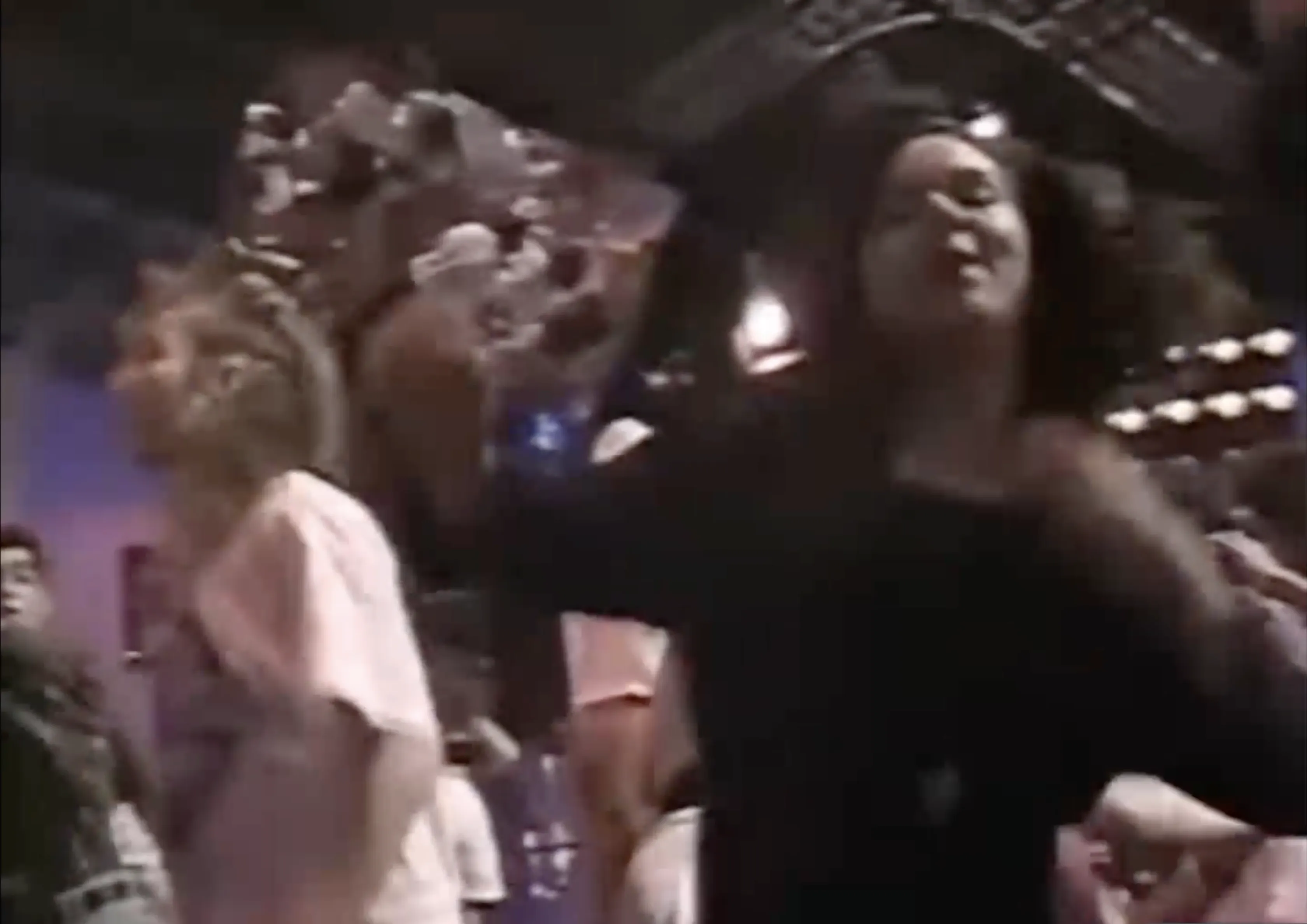
Splitting your audio output
![]()
Phoscyon comes with great FX routing out of the box. You are getting a very strong distortion unit, next to chorus, EQ, limiter, reverb and delay. You can simply change the FX routing by dragging the tabs around. Easy right?
![]()
![]()
![]()
On top of that, I like to control my audio output as well. I typically split the output in 3 parts to apply a low-end boost at the bottom, saturation in the middle and delay at the top. I also add some Decimort bit crushing at the top-end to make it extra phat.
Splitting up your audio like this allows for extra refinement and control.
And That’s a wrap!
Hope you enjoyed this.
Check D16, and check the video version of this tutorial.
Subscribe to our YouTube channel if you want to learn more about iconic synths and effects.
Definitely check out D16. These guys have the most amazing plugins. Highly recommended.
Peace out my friends :) 🖖
BBJinx
